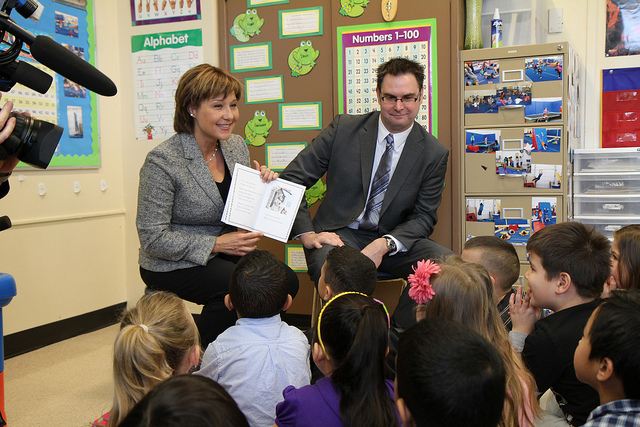Please support our coverage of democratic movements and become a supporter of rabble.ca.
If I didn’t know otherwise, I’d think that students in this province were all under the supervision of clones of Thomas Gradgrind — who saw students as empty pitchers to be filled with the right type of knowledge. If you read between the lines of the new plan, teachers have apparently been stuck in the “content delivery” mode and are in need of adjustment into their new role of “guide, coach and mentor” so that students’ learning can be “personalized.”
I don’t even know where to begin to unravel this fallacy and all the other false assumptions threaded through the entire project.
Let’s start with what I do as part of my job of teaching:
I research, analyze, evaluate, discern, strategize, judge, plan, learn, adjust, lead, monitor, assess, decipher, negotiate.
I synthesize, prioritize, demonstrate, create, observe, administer, calculate, improvise, construct.
I empathize, organize, engage, motivate, support.
And when I’m not doing all that, I guide, mentor and coach.
So I’m completely confused about the emphasis on how teachers need to change their roles in the classroom. What did they think we were doing all this time?
As for personalized learning, I do not know what other kind of learning there is. All learning is personal! That’s the way we humans are wired. We are personal meaning makers, each of us making unique sense of the world around us. If 30 students are presented with the same information, they will all learn that information differently, personally, based on who they are, where they’ve been, and what they’ve previously learned. Teachers already know this.
I have been giving students course credits for personalized projects since I began teaching decades ago.
I once had a student who hated to read but loved doing graffiti art. To make up for much of all the work he didn’t do in class, I asked him to research the history of graffiti, to plan and present information about all kinds of graffiti and to demonstrate to the class how to do graffiti. He did an amazing job, I would have let him spend the entire semester exploring even more aspects of graffiti art.
He could have studied it through geography, law, anthropology and psychology — if I didn’t have to also get him ready for the mandatory Grade 10 English provincial exam.
Teachers adjust assignments and projects to better suit students’ personal needs. They invite students to personalize their learning. This is not new.
But the B.C. education plan doesn’t mean personalization in this way. When the new plan mentions personalization, it actually means “technologization.” It’s no secret that multinational corporations see lots of profit to be made in the “education sector.” And governments who see themselves as bookkeepers like the idea of not having to spend money on teachers’ salaries when students are “learning” from online courses, sitting in front of their personal computers.
To think that this was a good idea, you’d have to completely disregard all the research that reveals all the negative effects of excessive screen time on the brains and bodies of children and teens. You’d have to also ignore the fact that we are social beings, hardwired to be connected to other human beings. What kind of students will graduate from an education system that has encouraged them to “learn” in isolation from other human beings?
Whenever I take my students to our school’s computer lab, even though they each have access to their own computer, they will gather in groups around a computer so that they can discuss what they’re watching. They like to learn together.
Teachers have been embracing change and innovation long before “21st century teaching” became a buzzword.
If you don’t want to take my word for it, you could ask the superintendent of our district who wanted to learn first hand about what was happening in classrooms. He sent out a request to all teachers in the district, asking to be invited into classrooms. During his visits, he discovered that there was lots of innovative teaching happening all around the district. He did not come across a single Gradgrind clone. He now has a very clear idea of not only what teachers are doing to prepare students for their futures, but he also knows what teachers need for the work that they do.
A new curriculum is not on the top of that list.
I wish the people from GELP who are behind the “education reform” all over the world, could visit the classrooms of even a fraction of the teachers in this province. If they did, they would realize that there is no need to tell teachers that students’ learning should be personalized. There is no need to tell teachers to integrate technology into their teaching. Or that they need to prepare students for the twenty-first century. Teachers are already doing all this despite a dearth of resources due to massive cuts to funding.
Imagine what teachers could do if schools were funded the way they were when the current graduating class was born.
Students entering Grade 12 next week have the misfortune to have entered kindergarten soon after the formula for funding public education was changed. They will graduate in June 2016 having spent 13 years making do with overcrowded classrooms, outdated resources, and obsolete technology. Some of them will have waited years to see a school psychologist. Many of them with learning disabilities would have gone through exhausting struggles to get to Grade 12 without any education assistant support. Many of their peers in kindergarten didn’t survive those struggles.
Where was all the fanfare about personalized learning when they needed personal help with their learning?
Please support our coverage of democratic movements and become a supporter of rabble.ca.
Image: Flickr/BCgovphotos




